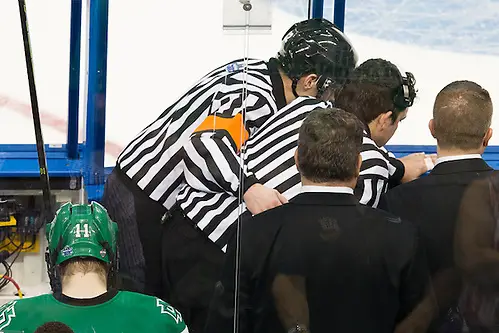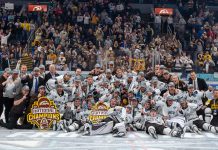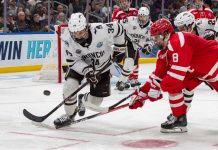
TAMPA, Fla. — With 6:25 remaining in regulation and the game tied at 2-2 in Thursday’s second semifinal between North Dakota and Denver, a big hit along the boards by North Dakota’s Trevor Olson required the game officials to take an extensive look at the play via video review.
Thanks to a new rule inserted into the rule book before last season, referees in the postseason are allowed to look at plays that could result in a major penalty to verify whether the play warrants a minor, major, major plus game misconduct or major plus game disqualification.
On this play, Olson’s elbow made contact with the head of the Denver player. But the big question for on-ice official Jamie Koharski, who was in perfect position to see the play, was where the point of contact was.
Steve Piotrowski, secretary of rules for the NCAA, and Frank Cole, head of officials, allowed USCHO to view the replay, which had been modified to zoom directly to the point of contact, the same view Koharski was provided at ice level. It was clear that the elbow initially hit the Denver player’s shoulder then rolled up into the head.
“You can see the point of contact [is the shoulder],” Piotrowski said as he played the video. “And then it goes up secondary to the head.
“In order for it to be a major, it has to be direct contact.”
Piotrowski said that the officials executed the entire sequence — from calling the initial penalty through the review — to a T.
“The referee [Koharski] is in perfect position. He can’t be any closer to the play looking down on it,” said Piotrowski. “They followed the protocol as appropriate: on-ice discussion before they went into review, followed by a video review and utilization of the video protocol as it’s available.”
CBS vs. Pacific Rim, by the numbers
If you knew anything about the two teams playing coming into Thursday’s semifinal between North Dakota and Denver, you knew about each team’s top line, and of course their respective nicknames.
For North Dakota, it is the CBS Line. For Denver, the Pacific Rim Line.
So how did each stack up by the numbers? The Fighting Hawks network-named line dominated. The C, Drake Caggiula, scored twice in the second period and assisted on the game-winner. The B, Brock Boeser, tallied two assists, including on the winner. And the S, Nick Schmaltz, scored the big goal, his only point of the night. The trio combined for seven of North Dakota’s 23 shots.
Denver’s Pacific Rim Line was hardly as productive. Although the trio of Trevor Moore, Dylan Gambrell and Danton Heinen combined for nine of the Pioneers’ 23 shots, they were completely held off the board. Heinen was the only player to get his name in the box score, taking a two-minute minor for high sticking at 8:40 of the third period.
Cautious start ties record low for shots
Despite some flurries in the opening period, Denver and North Dakota each mustered just four shots each, tying the lowest combined shot total for a Frozen Four game.
The 1996 title game between Colorado College and Michigan in 1996 produced five shots for the Tigers and three for the Wolverines during the first period. Never before has a period in a semifinal game produced fewer shots combined for both teams.
North Dakota vs. Quinnipiac all time
There was only one team in this Frozen Four field that Quinnipiac, a 3-2 winner over Boston College in the opening semifinal, had ever faced before, and that is North Dakota. The two will meet Saturday night for the national title and the Fighting Hawks enter that game having won all three of the previous meetings between the two schools.
Two of those games seem inconsequential now, a pair of home wins for the then-Fighting Sioux, 6-1 and 4-2 in October 2006. The most recent game, however, came in last year’s NCAA regional opening game when North Dakota beat the Bobcats 4-1 on March 27.
Notable for that game was that Sam Anas played with a significant knee injury. Anas will enter Saturday’s game injured as well, fighting a shoulder injury suffered in the ECAC Hockey title game that significantly limited his action on Thursday night.
You also don’t have to go to far back for the last time two No. 1 seeds met for the NCAA title. In 2014, Minnesota, the No. 1 overall seed, and Union, a top-seed in its region and third overall seed, met in the championship game with Union prevailing 7-4.


